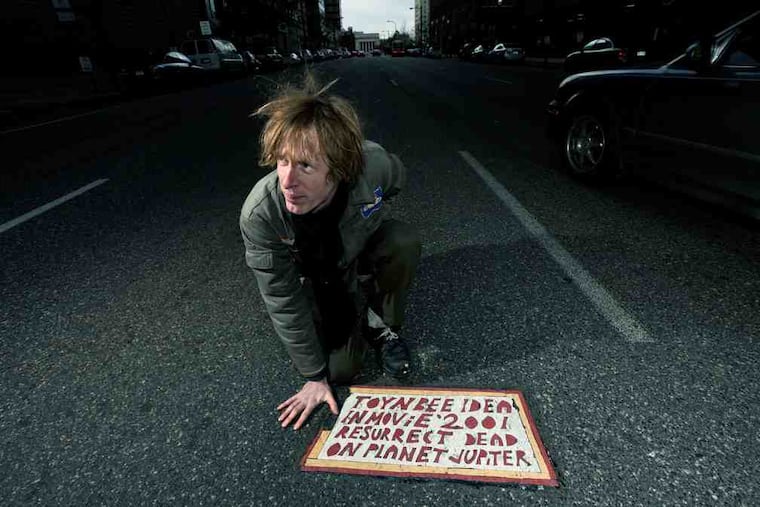Toynbee tiles have popped up in Scranton, keeping a Philly art mystery alive
Believed to be copycats, the tiles are set to be removed with the assistance of PennDot.

Toynbee tiles — the strange, mosaic rectangles with sci-fi-inspired messages embedded into asphalt by an elusive Philadelphia artist — have reappeared in Pennsylvania.
Now it’s Scranton’s turn to play host in the decades-old mystery.
Three tiles with elements of the Philly originals were recently spotted on streets in the city’s downtown. Their eerie message is familiar to those with an eye for art, though one Toynbee tile expert said these Lackawanna County pop-up pieces have different origins than their hometown counterparts.
First appearing in Philadelphia in the 1980s, hundreds of Toynbee tiles have since been spotted in 25 cities throughout the eastern United States, as well as in South America.
Typically around the size of a license plate, the linoleum tiles contain variations of the phrase “TOYNBEE IDEA — IN MOViE ‘2001 RESURRECT DEAD ON PLANET JUPiTER” and are placed into the street with a sealing tar, pressed deeper into the ground by cars driving over them.
The bizarre messaging is thought to be inspired by Stanley Kubrick’s 1968 film, 2001: A Space Odyssey, in which a crew of explorers is dispatched to the planet Jupiter. And researchers suggest Toynbee is a reference to the 20th-century British historian Arnold J. Toynbee, who wrote on human resurrection.
Two small tiles had cryptic “HH” and “21″ messages, the Scranton Times-Tribune reported. A third, larger tile read: “HOUSE OF HADES, THE RESURRECTION, OF TOYNBEE’S IDEAS, IN SOCIETY 2021, PUBLIC NOTICE.”
While the date suggests they were created last year, the installation’s timing is unknown.
Steve Weinik, a Philadelphia-based photographer and associate producer of the documentary Resurrect Dead: The Mystery of the Toynbee Tiles, offered one theory on the cryptic happening.
“House of Hades” is the moniker of an anonymous Buffalo artist, Weinik said, who works in the style of the original tiles. In a phone interview, Weinik called House of Hades’ output in recent years “pretty prolific,” though there’s no known connection between the artist and the Toynbee tile originator.
“It’s a different artist that’s using the same medium,” Weinik said of House of Hades’ Scranton work. “Sometimes it’s its own singular message, and sometimes it references back to the original Toynbee tiles.”
In the award-winning 2011 documentary, Weinik and an investigative team of Temple University graduates pored through web archives and letters, concluding that the person behind the original Toynbee tiles could be Severino “Sevy” Verna, a Philadelphia resident. That’s not to be confused with Verna’s uncle, who shared the same name and was husband to former Philadelphia City Council President Anna Verna.
According to the researchers, a man began contacting media outlets in the early 1980s with strange messages about Toynbee and the planet Jupiter, though the campaign was brushed aside by journalists. Through interviews, the team also discovered small, “proto-tiles” laid near Verna’s residence, and reports that Verna fashioned a hole in the floor of his car to lay the tiles discreetly on bustling city streets.
But when Verna was asked about the tiles, he denied any involvement, and the documentarians have yet to confirm the identity of the mysterious tile-maker.
Toynbee tiles can be traced throughout Philadelphia’s grid. According to Weinik, a tile was most recently located in late 2019 or early 2020 near Oxford and Cottman Avenues in Northeast Philadelphia.
“You might still be able to see a remnant,” Weinik said of the Northeast tile, “but it never really set correctly and it was kind of messed up. But it was definitely the original artist.”
Curious Scrantonites now have limited time to get a glimpse of the wondrously weird occurrence.
According to Jessica Ruddy, a spokesperson for the Pennsylvania Department of Transportation, the tiles are on a state-owned road and will be removed. The department is working with the City of Scranton to determine who will be responsible for the job.
As for why the tiles are being beamed back to the mothership, Ruddy pointed to regulations from the Federal Highway Administration, which consider the tiles an “aesthetic interior treatment,” and ban them.
In Philadelphia, however, Weinik said that the city has historically left Toynbee tiles largely untouched. And while the tiles’ origin may forever remain unknown, Philadelphians can expect more tile art to pop up around town.
Stikman, the anonymous Philadelphia artist known for his tiles depicting small robotic characters, continues to embed work in streets throughout the city.
“I’ve watched him put one down,” Weinik said of Stikman. “I didn’t even see him do it. He crossed the street, and then when I crossed the street a minute later, there was one that wasn’t there a minute before.”
Looking to track down a Toynbee tile near you? Try using the interactive Toynbee Tile Web Map.